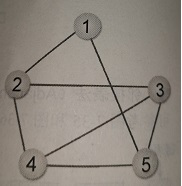从图的某个节点开始遍历,访问了则标记下来,然后遍历此点邻域中且未访问的点为新起点,且做上访问标记,通常通过递归和队列的技巧实现。

1:以1为起点,[2,5]入队列
2:取出2,相邻且未标记访问的3,4入[5,3,4]
3:取出5,入3,4;[3,4,3,4]
4:取出3,入4;[4,3,4,4]
5:取出4,剩余[3,4,4]
6:[3,4,4]均被标记访问,依次弹出,不打印、访问节点
最终深度优先遍历依次访问节点:1,2,5,3,4
from collections import deque
class list_node:
def __init__(self):
self.val = 0
self.next = None
def bfs(current):
'''
广度优先遍历
:param current:起点
:return:
'''
node_deque = deque([])
if len(node_deque) == 0:
node_deque.append(current)
# 节点访问标记
run = [0] * 9
while len(node_deque) != 0:
out = node_deque.popleft()
if run[out] == 0:
print('[%d]' % out, end=' ')
run[out] = 1
ptr = head[out].next
while ptr != None: # 遍历所有current节点连接的节点
if run[ptr.val] == 0: # 连接点未访问
node_deque.append(ptr.val)
ptr = ptr.next
def print_head(head):
'''
打印函数
:return:
'''
for i in range(len(head)):
ptr = head[i]
print('顶点%d=>' % i, end=' ')
ptr = ptr.next
while ptr != None:
print('[%d] ' % ptr.val, end=' ')
ptr = ptr.next
print()
def graph_create(data):
'''
创建链表表示图
:return:
'''
global head
for i in range(len(head)):
head[i] = list_node()
head[i].val = i
head[i].next = None
ptr = head[i]
for j in range(len(data)):
if data[j][0] == i:
newnode = list_node()
newnode.val = data[j][1]
newnode.next = None
ptr.next = newnode
ptr = ptr.next
data = [[1, 2], [2, 1], [1, 3], [3, 1],
[2, 4], [4, 2], [2, 5], [5, 2],
[3, 6], [6, 3], [3, 7], [7, 3],
[4, 5], [5, 4], [6, 7], [7, 6],
[5, 8], [8, 5], [6, 8], [8, 6]]
head = [None] * 9
graph_create(data)
print_head(head)
print('1节点开始,广度优先遍历:')
bfs(1)
print()
output:
顶点0=>
顶点1=> [2] [3]
顶点2=> [1] [4] [5]
顶点3=> [1] [6] [7]
顶点4=> [2] [5]
顶点5=> [2] [4] [8]
顶点6=> [3] [7] [8]
顶点7=> [3] [6]
顶点8=> [5] [6]
1节点开始,广度优先遍历:
[1] [2] [3] [4] [5] [6] [7] [8]